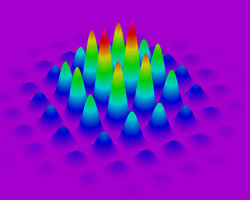Atoms Team Up to Slow Down

Teamwork may make things go faster for people, but for atoms it can have just the opposite effect. Reacting to laser light, atoms in a moving cloud can team up to slow the cloud down, researchers report in the 14 November issue of PRL. The energy-siphoning process might someday allow researchers to catch gases of molecules, instead of atoms, and cool them to near absolute zero–something standard laser cooling techniques cannot do.
In the past two decades, physicists have used laser light to trap gases of atoms and chill them to a fraction of a degree. Such technological wizardry netted a Nobel Prize in 1997. It also set the stage for producing a new state of matter known as a Bose-Einstein condensate, in which many atoms crowd into a single quantum state to form a laser-like matter wave.
Yet, current laser-cooling techniques have limitations. Atoms possess distinct internal states, and today’s cooling techniques work only for atoms that can flit back and forth between a specific low-energy state and a specific high-energy state over and over in a cycle. But many atoms and essentially all molecules possess many low-energy states. When an atom or molecule flops into the wrong low-energy state, the cooling cycle abruptly halts.
Researchers may be able to get around this problem by coaxing atoms to interact with light as a team, report Vladan Vuletic of the Massachusetts Institute of Technology in Cambridge and his colleagues. The researchers shined a laser horizontally through a falling cloud of cesium atoms and off the mirror on the far side. By chance, the atoms redirected some of the light toward precisely spaced mirrors above and below. Altogether, the light waves ricocheting back and forth and up and down reinforced each other in some places and cancelled each other elsewhere, to create a checkerboard of bright and dark spots.
Simultaneously, the atoms rearranged themselves. The light made the electrons in each atom oscillate back and forth from one side of the atom to the other. The “polarized” atoms could then reduce their energy by migrating to and hovering around the bright spots to form their own checkerboard pattern. In this configuration, they worked collectively to redirect, or diffract, more light toward the mirrors above and below, just as the atoms in a crystal lattice can redirect x rays. Thus, the rearrangement of the atoms amplified the light pattern. Most important, the falling atom checkerboard slipped over the light checkerboard only grudgingly and in jerky steps, much as a cleated soccer shoe resists sliding across a grate. That friction-like drag slowed the moving cloud of atoms to a standstill, although each atom continued to move randomly near its place in the array.
The researchers have slowed an atom cloud as a whole, says Peter Domokos, a theorist at the Hungarian Academy of Sciences in Budapest, but they must still show that, as is predicted, the process also draws heat out of the cloud. “I don’t think they are far” from that goal, Domokos says. William Phillips of the National Institute of Standards and Technology in Gaithersburg, Maryland, notes that cesium can be cooled by conventional methods, but that the new technique might allow researchers to catch and cool any particle that can be polarized. “The question is, can it work for something else where the standard technologies are not going to work?” says Phillips, who shared the 1997 physics Nobel Prize. “That remains to be seen.”
–Adrian Cho
Adrian Cho is a freelance science writer in Grosse Pointe Woods, Michigan.


